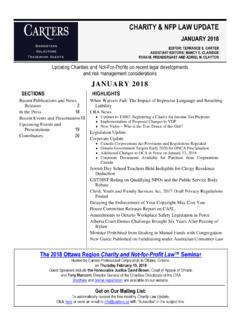Transcription of Michele Colucci Felix Majani 1. Introduction
1 AFRICAN SPORTS LAW AND BUSINESS BULLETIN 1/2013 SPORTS SPECIFICITY IN THE WORLD OF DOPINGby Michele Colucci * and Felix Majani **SUMMARY: 1. Introduction The anti doping rules and anti trust Theanti doping rules and the right to privacy 2. Doping disputes and the law applicable world of sport has certain rules established for purposes of organisation andorder. Based on their objectives, these rules might not contravene other internationallaws and it seems a prerequisite that in order for these rules to be compliant withthe said international laws, their anti-competitive effects, if any, must be inherentand proportionate to the objectives so-called specificity of Sport is quite a vague concept whichnevertheless has a significant impact on the application of both the EU law andinternational laws to the Sports Associations and to those who are registered withthem (clubs, players but also coaches and trainers).
2 Specificity encompasses all the characteristics that make sport special. Itincludes, for example:a) the specificity of sporting activities and rules such as separate competitionsfor men and women,b) limits on the number of participants in competitions,c) the principle of promotion and relegation,d) the principle of a single federation per sport,e) a pyramid structure of competitions from amateur to professional level,_____ Professor of European Union Law, European College (Parma); Assistant Professor in Internationaland European Sports Law, Tilburg University. Member of the FIFA Dispute Resolution Chamber,European Commission, Communication on Developing the European Dimension in Sport,COM(2011) 12 final, available on International sports lawyer and consultant.
3 LLM International Sports Law, ISDE Michele Colucci and Felix Majanif) the need to ensure uncertainty concerning outcomes and to preserve acompetitive balance between clubs taking part in the same sports like football, it has extended to a level whereby:a) clubs pay transfer fees in order to acquire the services of players undercontract,b) clubs pay training compensation and/or solidarity mechanism duringtransactions with fellow clubs for the transfer of players; andc) to playing rules such as the offside rule, yellow cards, is this specificity which continues to hold certain sports like football abackin as far as the use of video technology1 is specificities have indeed been recognized under the EU laws, asevidenced in the ECJ judgments and even more so under the Nice Declaration in2000 which expressly recognizes the right of sports bodies to organize and promotetheir respective sports, in particular as regards specifically sporting aforementioned aspects are taken into account when assessing whethersporting rules comply with the requirements of EU or other international laws,such as antitrust laws, laws safeguarding individuals against invasion of privacyetc.
4 But of all these peculiarities attributed to the specificity of sport, one standsout sports anti doping anti doping rules and in particular those enshrined under the WorldAnti Doping Code have over the years raised controversies and been the subjectof discussions in relation to contentious provisions and criticisms in as far as theyrelate to other international despite this, the WADA Code has managed to withstand the storm andcontinues to reign. How is this? How specific are the provisions of sports antidoping rules to the extent that they have still remained in force regardless of themhaving the potential of infringing and/or violating other laws? What is so specificabout sports and its anti doping rules? What other features or laws are exclusivelyapplied in doping matters?
5 The first step towards answering these questions is to remind oneself of whysports claims or wants to remain specific. It is obvious that sports is unique. It isnot just any other activity. It is nowadays both a social activity and a profession. Itis therefore imperative that legal issues be left best and addressed by experts whohave vast knowledge and experience of the intricacies of sports; or else we mightend up having a wide range of conflicting sports laws and jurisprudence. It is inlight of this that the International Olympic Committee, in collaboration with sports international federations established the Court of Arbitration for Sport in Lausanne,Switzerland. Its main task is to adjudicate and arbitrate on sports matters atinternational level, and it is sports highest arbitral Despite calls for the Introduction of video technology, some quarters in FIFA still advocate for themaintenance of the status quo, arguing that video evidence would take away the passion associatedwith the rules of the game as it is specificity in the world of doping 11 This article explores sports specificity in the realm of its anti dopingregulations in as far as they relate to antitrust laws.
6 The international privacy lawprovisions and the laws applicable to doping anti doping rules and anti trustPerhaps the greatest challenge yet made to sports anti doping rules took placebefore the European Court of Justice (ECJ) in the famous 2006 case C-519/04 P,Meca-Medina & Majcen v. brief, this was a case filed by two professional swimmers who were on 8august 1999 banned by world swimming governing body the FINA for four yearsfor using a prohibited substance, appealed the ban to the CAS but neverthless lost as the CAS upheldthe 4 year ban in February thereafter, new scientific evidence emerged which exonerated themfrom 100% blame and on 23 May 2001 the CAS reduced the ban to 2 swimmers did not give up and took the matter to the ECJ.
7 Theychallenged the compatibility of certain regulations adopted by the IOC andimplemented by FINA and certain practices related to doping control with theCommunity rules on competition and freedom to provide arguedthat the anti doping rules contravened the EC treaty rules on competition, and inparticular articles 81 and 822 thereof. They also alleged that the IOC s adoption ofa mechanism of strict liability and the establishment of tribunals responsible forthe settlement of sports disputes by arbitration (the CAS and the ICAS) which areinsufficiently independent of the IOC strengthens the anti-competitive nature ofthe came out of the resulting judgments issued by various levels of theECJ courts is what today distinguishes sports anti doping rules and makes various instances of the ECJ courts dismissed the swimmer s case andcame up with the following precedents: The anti-doping rules were pure sports rules falling outside the scope ofthe EU competition law.
8 The free movement provisions of the EC Treaty did not apply to puresports rules (such as the anti-doping provisions) since this kind of rule hadnothing to do with economic Article EC Treaty: The following shall be prohibited as incompatible with the internalmarket: all agreements between undertakings (..) which have as their object or effect the prevention,restriction or distortion of competition within the internal market (..). Article Treaty: Any abuse by one or more undertakings of a dominant position within theinternal market or in a substantial part of it shall be prohibited as incompatible with the internalmarket in so far as it may affect trade between Member States. 12 Michele Colucci and Felix Majani As long as the anti doping rules remained limited to their proper objectiveof ensuring fair play, and contained no element of discrimination, then itwas not for the Court (or the European Commission) to judge whether ornot the rules were excessive or disproportionate.
9 Since the anti doping rules in question were sporting in nature the mattershould be dealt with by the relevant sports dispute resolution bodies. The anti-doping provisions concerned the ethical aspects of sport and werenot subject to the restrictions imposed under the EC Treaty, even if theyhad some or other ancillary economic consequences. This was becauseany economic aspect of the rules was clearly secondary to their can hence be concluded from the Meca Medina judgment that it is safeto say that although the anti doping rules might have some economic impact onathletes, this impact is overridden by the need to ensure the maintenance of fairplay in sport a specific and unique feature of sport. Indeed, the anti doping rulesensure that an athlete s right to compete goes hand in hand with the need to do soin a fair and honest can also conclude that doping issues can only be heard before sportsdispute resolution bodies and no other The anti doping rules and the right to privacyIn further efforts at combating doping, the WADA requires athletes to:a) Provide information in relation to their whereabouts and be subject totesting 24 hours a day, 7 days a week, 365 days of the year;b) Identify their location for each day in the following three months andupdate it should it change.
10 Andc) Specify one hour each day (between 6am and 11pm) during which theycan be located at a specified location for by an athlete to be found at the place he claims to be constitutes amissed test. Moreover, submission by the athlete of incomplete or inaccurateinformation constitutes a filing failure. Both missed tests and filing failures constituteWhereabouts failures. Under the WADA Code, three Whereabouts failures in 18months constitute an anti-doping offence, and consequently may lead to asuspension of a minimum of 12 months, and a maximum of two For further reading, please see Meca-Medina: a step backwards for the European Sports Modeland the Specificity of Sport? by Gianni Infantino, UEFA Director of legal Under of the WADA Code Violation of applicable requirements regarding Athleteavailability for Out-of-Competition Testing, including failure to file required whereabouts informationand missed tests which are declared based on rules which comply with the International Standardfor Testing.








